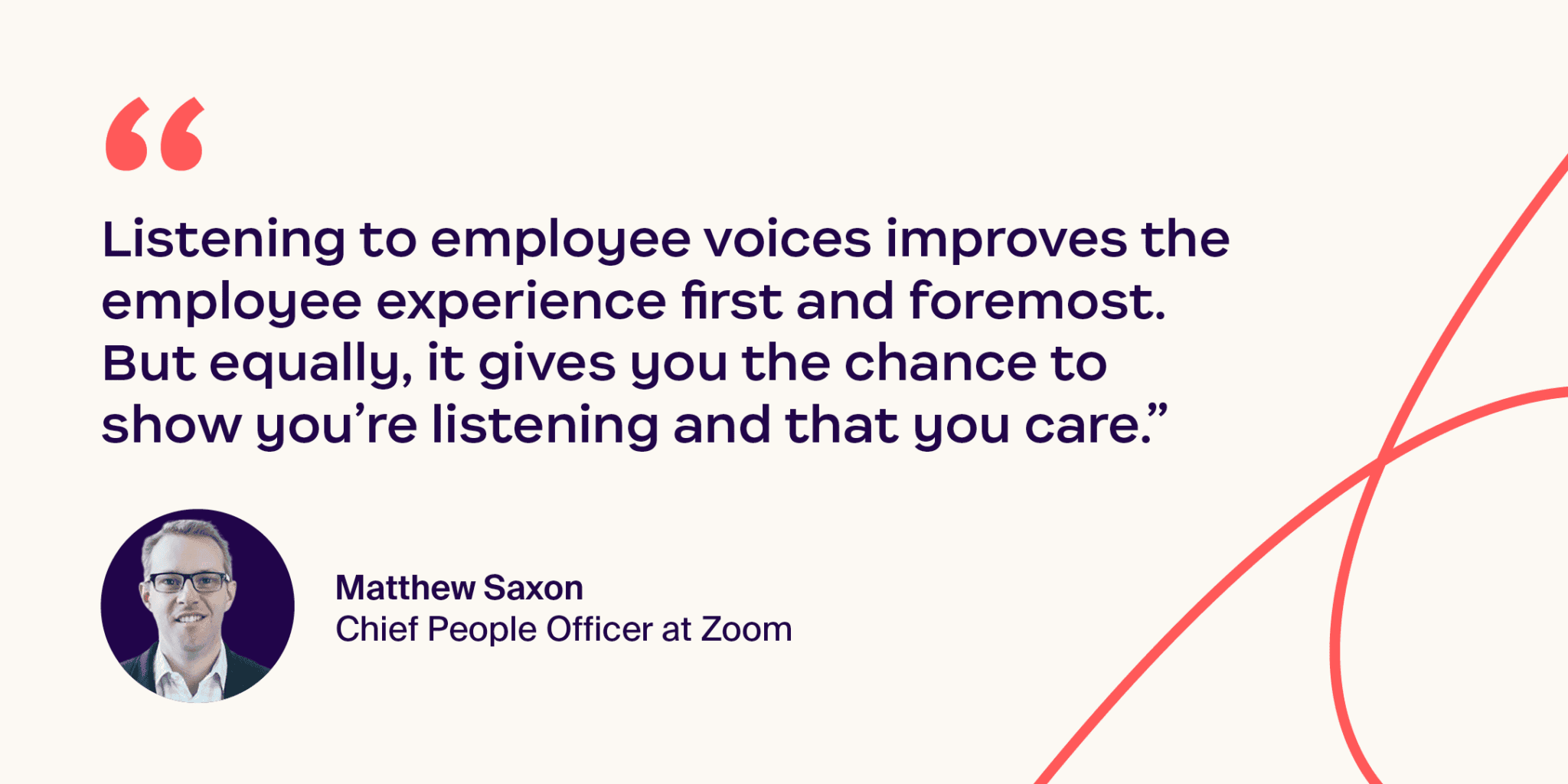Leading Your Team To Thrive in Hybrid 2.0

Matthew Saxon
Chief People Officer at Zoom
6 Nov 2023

Zoom’s Chief People Officer Matthew Saxon shares his advice for teams hoping to stay ahead of the curve in the world of Hybrid 2.0.
Those of us in people leadership roles, in HR or communication roles – we’ve been through a lot over the past couple of years figuring out new ways of working. We’ve had to work out how to close offices and then reopen offices and get people productive and connected.
Hybrid 1.0 was really around the pandemic coming and all of us having to figure out how to survive. What we’ve established is that we can indeed survive when we are not all co-located and working in synchronous ways. So, surviving? Check.
But the question a lot of us are asking now (as we move up the human needs hierarchy) is how do we thrive?
How do organizations, people leaders, HR functions, and comms teams actually help their employees thrive in these new ways of working? I don’t think there’s one size that fits all. We need to think about the ‘where do you work’ concept as a continuum.
On one end is getting everyone in the office. We all know what that’s like. And at the other end of the continuum, everyone’s remote. Again, many of us know what that’s like too. But now we’ve reached the middle of the continuum: hybrid.
This is where a lot of knowledge-based companies are today. There are two main flavors of hybrid; one is ‘flexible hybrid’, which is when people come in on any day they want, work out of the office, and then go back and work remotely for the rest of the time.
The other way is what we call ‘structured hybrid’, which is when people come into the office on set days, and so there’s more of a structure around which days they’re coming in and which days they’re not.
The Hybrid 2.0 model you choose really depends on what kind of company you are. There are three things I consider when I’m talking to other businesses about where they want to be on that continuum.
1. What’s your ‘why’, and what’s the nature of the work?
Explain the why – Each company is unique and it’s the Companies that have really thought about their why that are doing it best. If you’re in supply chain, if you’re in a retail environment, if you’re in manufacturing, the nature of the work means that the majority of your workforce has probably been coming into the workplace for a long time.
Other types of organizations have more options; the nature of our work is that we don’t have to be in a workplace location. And for lots of companies, Zoom included, our workforces is now in a broad number of locations as people moved and we hired with a “talent first” approach that is significantly different to what we had before the pandemic. This has led to a large portion of our staff living in locations where we don’t have any offices, which adds a logistical and practical element to the mix.
2. How can you optimize the work?
How is your work performed? Figure out how much time people need to be together working synchronously, and how much of their time can actually be optimized through being at home or being in another location.
There’s a bit of a tug-of-war happening right now between employers who want to bring people to the office more frequently and employees who might not want to.
Employees are justifiably asking, “Hey, I’m able to get my work done, so why are you bringing me back to the office?”. Here at Zoom, one of the insights we had early on when we started to bring people back in from our product and engineering teams was that the office has to earn its commute.
What we found was that people were coming in and they were doing the exact same thing that they were doing at home – just in an office setting. They were coming in, they were going on Zoom calls and they were doing their individual contributor tasks – to-do list-type work.
And what we heard was, “I’m not sure the office is earning my commute because I could have done most of what I just did in the office at home.”
We had an ‘aha moment’, which was this: the value of the office for us was not in people doing their individual task work, it was actually in all of the other things that are enhanced when people are together, be that brainstorming sessions, strategy sessions, or training and learning. It helps foster connection.
That unlock helped us decide where we wanted to be on that hybrid spectrum, and we landed on structured hybrid. This helps ensure people on the same team are coming into the office on the same days which maximizes connections.
But constantly adapting to evolving needs is key. People told us that even though structured days in the office meant they’d be onsite at the same time as their teammates, for example, having to sit away from them on a different floor was getting in the way of their flow.
Because of that, we’re now looking at how we think about neighborhoods from our reservation solution where people can book desks in a neighborhood, so all of the finance team can sit in a finance neighborhood on a particular floor on a particular day.
It’s these insights that are really helpful.

3. How will you communicate the changes brought by Hybrid 2.0?
Make sure you’ve got a really solid communication plan. Communication is two-way; we tend to lean on communicating to our employees, but it’s equally important you’ve got a really solid solution where you can very quickly understand what’s top of mind for your people and how to take those insights and move them into action.
We’ve just closed a survey for all of our locations in the US to share feedback with us and we got some really good engagement, from ideas for product enhancements to what people want to see in their employee benefits and how we can better foster deliberate connection.
Listening to employee voices improves the employee experience first and foremost. But equally, it gives you the chance to show you’re listening and that you care. Even when you can’t do anything for a particular employee in a particular situation, being open and honest with them as much as you can is really helpful.
Take hybrid working as an example. There’s a bit of resistance to the idea of someone telling them they suddenly need to work in an office some of the time. The more you can turn that into a conversation and an ongoing dialogue – and explain why you’re trying to do what you’re trying to do – then employees will give you a lot of latitude.
But there are practical aspects of your comms plan that need to be considered too. If you’re thinking about moving to more of an in-office environment, you can’t forget that you’re changing people’s routines. Their day-to-day lives – so you need to give them plenty of heads up, but also have a clear plan for the exceptions you’ll make for individual circumstances and be flexible to give time for people to adapt.
As a people team here at Zoom, we ask ourselves, “Can we look the person in the eyes and say we’re being reasonable?”
That’s a great litmus test that we use internally to stay true to our value of care.
This goes without saying, but your employees aren’t a homogenous group. I was walking through our offices the day we officially swapped to a hybrid work model and I came across a range of views. Some really liked the feeling of a thriving office whereas others were not ready to embrace the change. Making sure you have an avenue to hear and understand all of those different perspectives is crucial.
Hybrid 2.0 and the future of work
As we collectively evolve hybrid models, we have to unlearn traditional ways of working, traditional ways of communicating, traditional ways of making sure that everyone’s on the same page, and traditional ways of having people interact and engage with each other.
When we talk about Hybrid 2.0, it’s really about how we enable thriving and a big part of that is connection. How do people really feel connected to each other, to the mission and vision of the company, to the strategy, and then to the work itself?
Figuring that out can be hard, and for new hires in particular, it requires us to really think about how you’re onboarding and orienting your new hires in a way that’s winning hearts and minds instead of just setting up their IT equipment. Being deliberate and purposeful about building connection will be a big unlock for us all.
I hope these insights prove helpful as we all go on this journey together. The more we continue to have conversations together, the more effective we can be.

